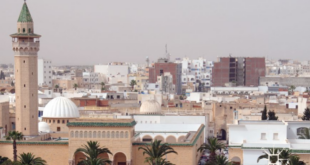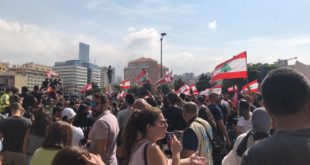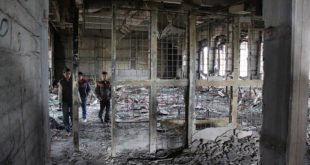Growth of new technology is changing the way news is covered around the world, especially in remote locations where satellite uplink doesn't exist and where bringing in equipment is difficult if not impossible. TBS spoke with two Nairobi-based journalists—Khalid Kazziha, APTN senior producer for East/Central and West Africa and Nadia Bilbasey, Africa correspondent for MBC (Middle East Broadcasting Centre)—about how satellite phones can mean better coverage of breaking news, and about cooperation in the field between news stations and news agencies.
TBS: Tell us first about the technology you're using now to feed stories from the field.
Khalid Kazziha: Over the last four years the agencies have begun introducing something called a TOKO box, which allows you to take video and audio signals, compress them, and put the output of that into a telephone called Inmarsat B, a big telephone capable of processing high-speed data. You can then call a number in, for example, London, access an ISDN line, and load the data into a TOKO box in London. It then gets decompressed and put onto Beta or any other format.
The down side is that it takes time; a minute of video takes about half an hour to transmit. It could be potentially hazardous to health because it uses strong radiation signals, so people have to be careful working around it. It's getting smaller and smaller; right now the whole package together, including editing, camera, and Inmarsat B, plus a generator, is about 200 kilograms. We're looking at ways of reducing the weight, making it even more convenient, more practical, less costly in terms of excess baggage. If you want to strip out the editing equipment out and just go straight from the camera into the TOKO box and into the phone, it's around 50 kilos. You can potentially transmit images from anywhere in the world with just 50 or 100 kilos of equipment, without the complications of earth stations, master control rooms, and with only a producer and a cameraman in the field.
TBS: Can you give us some examples of stories on which you've used the TOKO?
Kazziha: This technology has been used extensively in coverage out of Afghanistan during the hijacking, for example, and in sending out pictures during the Indian earthquake-initially there was no electricity in Gujarat province, the infrastructure had been completely devastated. It took a while for them to bring in satellite communication equipment, which weighs tons, and all the engineers. The news had to be moved quickly, people needed to know what was going on instantly. With this new equipment it's just a question of carrying and paying for your excess baggage, and flying in.
Same with the Ethiopean famine-Ethiopia has a feed point, but the front line is so far away that it would take a day or two to get from the front line to the feed point in Addis Ababa. We've used it in Guinea-Bissau, wars that no one ever thought of covering and which were not coverable before. When the war in Kosovo was cooking there were something like 50,000 refugees, and the eyes of the world were focused on the conflict. Meanwhile in Guinea-Bissau there were around 500,000 internally displaced people, a story which would never have been told without the use of this latest equipment.
TBS: Do you think it will change the way both networks and agencies cover the news or choose what gets covered, because they are technologically able to cover more? What do you think the implications of this technology are for editorial choices?
Kazziha: I don't think too much. First, all this equipment has no impact on the developed world-Europe, America, the Middle East. Second, people are still more interested in having top-quality broadcast transmissions.
TBS: How is the quality, compared to with satellite transmission?
Kazziha: It's slightly inferior to the existing satellite quality, but when you want to cover zones where there is no satellite capability, you don't have the luxury of quality, this becomes the only way you can get your pictures out. You'll notice CNN and BBC are now using live satellite video phones for standuppers out of, for example, Hainan Island with the China-US spy plane story. The video phone was used in India during the Gujarat earthquake, TOKO was used exclusively during the conflict in Sierra Leone, it's being used more and more. The important thing is not to have a lot of movement; too much movement affects the quality. It's unlikely that the person at home sitting and watching television will really notice a major difference. The broadcaster, the editor will notice that these are TOKO pictures, but it doesn't really make that much of a difference.
TBS: How many bureaus, agencies and channels use this technology?
Kazziha: Right now I know that the Associated Press and Reuters are relying on it extensively to get pictures to the thousands of broadcasters around the world. These are the two main organizations that are using these facilities, but I'm finding now that the BBC, CNN, and others are also using it.
TBS: It's more critical, obviously, to have this technology if your mission is to cover the world.
Kazziha: That's right. When we cover stories on ethnic cleansing in Indonesia, for example, a lot of small islands don't have satellite communications. It would be crazy for broadcasters to think they could delay the news for a day or more simply to ship their tapes to the nearest feed point to get the pictures out. People don't have the luxury of going back to Delhi or Bombay to feed. In Africa we find that satellite communications are available but very unreliable-and it's also cheaper sometimes for us to send with the TOKO. You can send two minutes of video for about $300.
Nadia Bilbasey: That's from the agencies' end, not for the client. Clients are charged about $1000 for two minutes of video.
TBS: You're looking at this, Nadia, from the other side-from the client's end rather than the agency's.
Bilbasey: That's right. To go back to your earlier question, I think our editorial decisions are sometimes influenced by the methods used to transmit pictures. Sometimes we don't like the TOKO, because of the lower quality--unless it's a situation in which there's no other way of getting pictures out, like a remote area in Africa. Generally speaking they prefer to use the main satellite means of communication when it exists. Between the two--TOKO, which you sometimes can't do without, and satellite communication--there are also companies like Newsforce. When they know for example that there is a war in Sierra Leone, and many journalists from all over the world are coming to cover the story, they move the entire communications setup to that place. The same in Kinshasa-we had Newsforce and European Broadcasting Union. They provide you with quality pictures for about half the price of the TOKO. Because in the end, for the client, TOKO is very expensive for poor quality.
Kazziha: But with organizations like Newsforce, it could take them a week to bring in all that equipment. They have to get a license in order to transmit. You're looking at governments that are facing a disaster, in the middle of a transition or a coup d'etat-but these organizations are required by law to have a license to transmit. Very often the minister or head of state isn't available. The flyaway satellites could be just sitting around in customs. But people still need to get the news out, today. We're able to sneak in this very simple equipment, which is compact and easy to deploy.
Besides, stations never have to send two minutes of material on breaking stories. Stations subscribe to Reuters or AP, so whatever we send via TOKO is available to them in their control rooms in London or elsewhere. So all reporters have to do is send a standupper and a voice track to the pictures AP sends. We line up our clients--CNN, BBC, MBC, Al-Jazeera, one standupper after the next--and they all use the same pictures. Which means the initiative of the correspondent can be limited sometimes by the fact that they don't have the ability to get their pictures out on breaking stories-but they always want to make sure they have presence on the ground, and that's what the TOKO allows them to do. In the initial phases of any disaster or conflict they need to show that they are there, even though they're cooperating with the agencies.
Bilbasey: And the situation can be reversed, too, such as when the war between Ethiopia and Eritrea broke out, I had my own cameraman rather than using the agency, and we had exclusive pictures that nobody had. MBC sold them to CNN and BBC, and made a deal with WTN that because they were using our pictures they wouldn't charge us for the TOKO. So there's lots of cooperation between different agencies and stations.
Kazziha: The client and agency relationship is very much give and take. On some stories my company isn't interested enough to paying the airfare and excess baggage, but a client might be interested in covering it. We might work out a deal where they pay for the expenditures of covering news, and we don't charge them the fees for hiring a cameraman. The correspondent becomes in effect the producer, and the agency the cameraman, and we're on location in a mutually beneficial arrangement.
| Bilbasey: One example is a story we did together in Kenya, of 60 children who were burned in a boarding school dormitory. It happened about 70 km out of Nairobi. For us the normal procedure would be to go to the location, take pictures, go back to Nairobi and edit, and go to KBC (Kenyan Broadcast Corporation) to feed the stories. But KBC can be very unreliable--you arrive and there are no technicians, or it sends sound but no pictures or pictures with no sound. And it's very expensive; they charge us about $3000 for ten minutes. So we rely on the TOKO in this case. Khalid took the equipment with him in the car, and we set up in the parking lot right outside the school.
Kazziha: Meanwhile the competition had to send the material 70 kilometers back to Nairobi, get a satellite booking if they're lucky. And we're getting the pictures out right from the spot-half an hour after we filmed, the pictures were in London and being distributed worldwide. Bilbasey: So it definitely has an advantage when there's an important story. But when it comes to a story like, for example, Burundi peace talks, my office would ask how I'm going to send the pictures, and I say by TOKO. They tell me to forget it. Because it's not that important and the quality won't be that good. With a breaking story it's different, you have to move, and then it does help. But generally broadcasters prefer quality, because the audience can't understand why the pictures aren't of very good quality. Kazziha: But I think that has an attraction-the TOKO pictures, because the signal gets compressed and decompressed, looks a bit like film in the 1920s, it's a bit choppy, and almost looks like you have a very high shutter speed on the pictures. In dramatic situations it has a dramatic effect. Things that move very quickly seem to slow down just a fraction of a second-cannon fire, guns, people running all starts to look a bit spooky and a little more dramatic. In covering disasters and tragedies, in a visual sense it works. If you're covering a press conference, there's no point. It looks unacceptable. |
|
| TBS: Is it worth bringing in a flyaway on a big story?
Bilbasey: It's hard to get a license. It's a good example of a location in the world where for technical as well as political reasons this technology becomes vital to coverage. And from Nairobi you're covering important areas like Rwanda, the Congo, Sudan, and from these areas you have to use the TOKO all the time. During the famine in Sudan EBU wanted to bring in flyaway satellite equipment and they weren't given the permission. |
The real threat agencies and organizations are facing is that of local stringers everywhere with digital cameras and laptop computers and the ability, as technology advances, to send images over the Internet. |
| TBS: Do you have this equipment in the bureau or do you have to access it from elsewhere?
Kazziha: We have one in Nairobi and are getting a second, one in Abidjan to cover West Africa. Organizations are renting them-in Sierra Leone, for the first ten days everyone had one, the BBC, French TV, Spanish TV. It's pretty straightforward to use, although a bit tricky technically because a lot of things can go wrong. You have to get a line up, have to have the right outputs, the right connection with the satellite, have the right signal. But it's still a lifesaver. Bilbasey: And the equipment itself isn't fragile, it doesn't break easily. One of our colleagues went to Congo, and for about 26 hours the equipment was in the back of a truck on non-existent roads, bouncing and shaking, with no problem. Kazziha: Now we're past the stage where this is pioneering, but as an example of where the impact really comes in and where journalism is at its best-during the famine in Ethiopia in the Goday region, the famine was being reported to have a radius of about 150 kilometers, that's the area that was assessed by NGOs. Beyond that area was insecure, there were no roads. We got an armed escort and went 400 kilometers outside the area where the famine was being reported, and transmitted images. In other words, we provided an informal assessment of the needs of people there, and highlighted that the problem wasn't contained within a 150 kilometer but more like a 600 kilometer radius, which means the famine is affecting a much, much larger population. On the way back we saw World Food Program convoys moving out in response to our pictures. And in Guinea-Bissau and unreported war was going on. The UN Security Council had not met to discuss the situation. The evidence of our pictures made it necessary for the Security Council to meet. There would have been no peace process if pictures hadn't started coming out of the region. It's easy for superpowers and the UN to ignore problems in the world if there's no press bringing them out. And that's where journalism works at its best, where you make a difference. TBS: In this same issue of TBS, a former CBS Cairo bureau chief discusses the tendency now especially in the American networks to just fly in a big name reporter when something major happens, rather than, as they used to, having people on the ground all the time who know the region, the history, the stories. The kind of journalism you're talking about is the reverse-not only are news agency or station correspondents on the ground based in an area, but thanks to technology you can go further in coverage than before. Kazziha: That's right-for example, with the cult deaths in Uganda last year our pictures were out within 24 hours after the incident. Big stars from ABC and NBC and others flew in and they had no way to transmit their pictures out. They had truckloads, a half a ton of equipment, sound and editing and everything, and they weren't able to send them out. It gives us the upper hand and a lot of power. We're talking about cameramen being able to manipulate public opinion. He's no longer just the guy who carries the camera and gets told what to do. If he has a little initiative the cameraman can actually shape what the world is seeing. Bilbasey: I don't really believe in the concept of an "international correspondent" who just gets flown in. Of course to be a journalist you have to have broad knowledge about the world, but you have to have specific knowledge about the region you're covering. American networks have maybe two people to cover the entire continent of Africa. And when something happens they fly in someone who doesn't know the area and has to rely on the entourage of people around them and simply appear in front of the camera. Kazziha: This technology will be obsolete in a few years. It's already becoming obsolete as people are able to use small digital cameras, edit on their computers, use a live wire, get a smaller version of the Inmarsat B phone. The face of agency business, of getting pictures out of these areas, is probably going to change once again as the technology keeps changing. The real threat agencies and organizations are facing is that of local stringers everywhere with digital cameras and laptop computers and the ability, as technology advances, to send images over the Internet. It will revolutionize the way people watch the news. Perhaps it will mean the news will come faster, and maybe it'll be told in a better way because it'll be coming from someone at the location. With my TOKO I cover maybe 15 or 20 countries; our region is really big. If our stringer in Congo or Rwanda has the ability to send pictures, we're not going to be traveling anymore. So I'm then the stranger, I don't have to be there to tell their story anymore. More and more, people in each location can tell their own stories. |
|
 Arab Media & Society The Arab Media Hub
Arab Media & Society The Arab Media Hub





